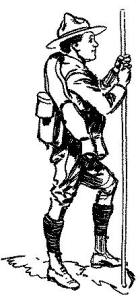 It’s been a couple weeks since my last post — a combination of travel, training programs and just plain “being overwhelmingly busy” have kept my blogging at bay.
It’s been a couple weeks since my last post — a combination of travel, training programs and just plain “being overwhelmingly busy” have kept my blogging at bay.
I read an article at Forbes.com that served as a good reminder to people who are fascinated by “leadership” topics and themes. It was a good reminder that effective leadership (as an action) can be demonstrated by everyone regardless of their position or title. Further, effective leadership is built on strong character. People, as followers, typically don’t respond well to leaders with significant character deficiencies or those who’s emotions can easily and frequently override their “higher judgement”.
Consider this quote from the article:
The high character associated with true leadership can be demonstrated and lived anywhere in an organization or community; it’s not about rank or title. People can lead by example very powerfully at the lowest levels of an organization when they demonstrate true excellence in how they answer a phone, relay messages, or interact with every person who seeks their assistance. People can lead from the middle when they build strong, resilient work teams with healthy cultures and excellent performance.
Naturally, people in higher positions are under constant and persistent pressure to derive greater efficiency and effectiveness from their teams and that pressure can take a toll on the best and strongest folks. It then becomes the responsibility of that leader to know when he or she needs a break to regroup.
The author of the source article summed it up nicely:
People called to lead from the top have a different level of responsibility, and it’s definitely not for everyone. They need to embody both high rank and high character. The most effective people who hold high ranks in organizations are often compulsive. They have to be. They are driven every day in every room to make their people and organizations more and more effective. It takes a lot of energy and focus, and it’s not a job for everybody.
 I see great examples of “grace under pressure” in the workplace from many different leaders and persons with “higher-up titles”. They are faced with disappointing results, time pressures, and demands to make improvements, but they are able to work with their subordinates to reassure, coach and redirect efforts without belittling or ridiculing failed efforts, mistakes, missteps or lackluster performance.
I see great examples of “grace under pressure” in the workplace from many different leaders and persons with “higher-up titles”. They are faced with disappointing results, time pressures, and demands to make improvements, but they are able to work with their subordinates to reassure, coach and redirect efforts without belittling or ridiculing failed efforts, mistakes, missteps or lackluster performance.
Character is the heart of the matter. Strong leaders with strong character understand that it’s fine to be angry over poor results, but the anger is directed at outcomes, not people. Even when people are clearly to blame, folks with strong character can discern the right path to motivate change by encouraging, educating or even inductive reasoning to help the affected individual or team by “drawing out” from them the realization of what went wrong and how to correct the direction for better outcomes.
I’ve also seen leaders fly off the handle with emotional outbursts. Thankfully, it’s rare, but it can happen. Its understandable when we recognize the immense pressure and long hours spent to try to achieve the nearly impossible results needed to satisfy the greater organization. In some cases, the leader is able to regroup, reconcile and recapture the respect of their followers, but sometimes that leader resorts to a path of bullying and blustery speech to intimidate followers into hasty and urgent action. Such sort term tactics may get a quick turnaround, but are unsustainable in the long term.
 Character is “who we are” at the DNA level, not simply how we act when under pressure. Character defines how we respond when we know we were wrong and how we share success with the team for good outcomes.
Character is “who we are” at the DNA level, not simply how we act when under pressure. Character defines how we respond when we know we were wrong and how we share success with the team for good outcomes.
One leadership model (developed by the US Army) is referred to as the BE-KNOW-DO approach. It starts by defining the individual’s character (BE = who am I, how do I react, what are my values as expressed in seven main areas of loyalty, duty, respect, selfless service, honor, integrity and personal courage) and builds on that core. The “KNOW” aspect is understanding what must be done and having a game plan to derive an outcome using available resources. The “DO” portion is simply taking action with urgency — initiating instead of responding.
When our leaders (by title or by virtue of influence) have got the right focus on areas like loyalty, respect, integrity and personal courage, its easy to follow them. When character is compromised, it’s very difficult to follow (especially for a sustained period of time).
